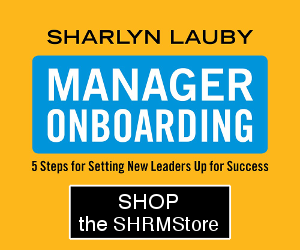
Co-workers play a huge role in the employee experience. An increasing number of organizations include peers in the hiring process so candidates can meet some of their co-workers. Companies are adopting new hire buddy programs as part of the welcoming and socialization process during onboarding. Multi-rater reviews (sometimes called 360-degree feedback) ask for feedback from peers as part of the process.
Another aspect of the employee experience that we don’t talk about much is peer to peer learning. Peer based learning can take place in both a formal or informal organizational setting. What’s great about peer to peer learning is that both the sender and the receiver can find the experience valuable.
I recently sat down with a friend and colleague of mine, Kathy Shurte, CPLP, CPM, district organizational development manager for the Florida Department of Transportation, to talk about peer to peer learning programs and the value they bring to employees and organizations. I’m thrilled that Kathy agreed to share her expertise with us.
Kathy, I’d like to think that everyone understands the value of peer-based learning, but as an in-house learning and development (L&D) professional, what’s your take?
[Shurte] As an L&D professional, my take on peer-based learning is that, while it is not a new idea, it certainly is an idea whose time has come! I know I provide a valuable service to my organization, and historically that value has been through training opportunities I’ve created, facilitated, provided, or recommended. That has all been good, and there is still a definite need for structured learning events.
But when I think back over my own life, there is no denying some of my most important lessons happened with a friend by my side, patiently showing me how to balance on ice skates or how to roast a chicken. Sometimes there was more laughter than patience, but a friend in need was still a friend. In the workplace, there was always someone who knew the job better than I did and was willing to let me learn from his or her mistakes. Getting me up to speed quickly was a win-win situation!
Fast-forward several decades and we live in a different time. The world has shrunk, we communicate differently, and the resources that are available to us are simply mind-blowing. ‘Change’ has become my new definition for life. How does one take it all in and learn to make sense of it? Peer to peer learning. No one has a training staff large enough to allow them to create a structured learning opportunity for every new app, idea, or thing that appears on the horizon with each day’s rising sun. But there is always someone, somewhere, who can grasp it and pass it on.
Now our role as an L&D professional must expand to embrace the fact that our ‘training team’ is everyone. We’ll have to look for trends, figure out how to ensure the information shared is accurate (or something that we want to be shared), understand how to quantify it, and know when to pick it up and add some structure to it. Peer-based learning is not going to go away; we need to embrace it and support it.
In your experience, what types of peer to peer learning programs can organizations implement with very few resources?
[Shurte] An organization can implement different peer to peer learning programs with very few resources. Our organizations are quickly filling up with young people who are tech-savvy and collaboratively conscious. We have two generations that have grown up wanting to share everything they do, have or know, and they use technology to share it with as broad an audience as possible (think global!). A smart organization will tap into that – and it takes very little to do so. Government organizations have more issues with technology and transparency, but private sector enterprises can allow employees to mingle personal devices and company resources to achieve amazing returns.
- Setting up social media sites (or internal versions of the same) allows employees to ‘show off’ an idea or skill.
- Mentoring programs now match mentors with new hires, and never mind that the mentor has yet to finish his or her probationary period. Of course, mentors with more tenure work well too.
- Setting up ‘sandboxes’ or ‘playgrounds’ where employees can explore applications provides a safe learning environment where failures are less painful.
- Creating ad hoc teams to address problems spurs innovation.
You’ve mentioned technology already, so let’s explore that more. Where can technology provide value in peer to peer learning?
[Shurte] It makes me sound old to say this, but kids today are wired differently! I’ve seen children just barely a year old pick up a smart phone and, not only find the games, but play them, too. Technology is like an added appendage. Who hasn’t at one time or another wished for an extra arm or two? Technology affords its gifted users an added advantage relative to communication, learning, researching and/or sharing information. It can hardly be separated from the person.
A caution, though, just as any strength becomes a weakness when it is over-used, we have a generation that struggles with interpersonal skills, and a peer cannot share what a peer cannot do. So as L&D professionals, we all need to be on the lookout for ways to help everyone maintain a swath of humanity.
Do you see a downside to peer to peer learning? And is there a way for organizations to mitigate the risk?
[Shurte] The downside to peer to peer learning is that left unto itself, there may be quality issues. If I only think I do a great job, and then I show all my friends how something is done, they won’t be great at it either. Also, we still have people in our organizations, often older and often senior, who don’t recognize or value any kind of informal learning, be it peer to peer or stretch assignments. L&D has a role in educating that faction on all the ways learning can take place.
Organizations can mitigate the risk of poor quality by including segments of peer learning in staff meetings or wherever groups of employees meet formally. Managers can be present, watching from a distance and then giving feedback when they see peer to peer learning taking place. Recognize it, and specifically say what made it good. If there is a way to formalize peer to peer learning, using a learning management system (LMS), an internal certificate/certification program, or even simple corporate badges – these can all help mitigate quality issues.
Last question. With the increase in collaborative work, what do you see as the future of peer to peer learning?
[Shurte] I see the future of peer to peer learning as another tool in my toolbox, something that is here to stay, something that I need to embrace and coach. If indeed any of us is a lifelong learner, the natural outgrowth of that is to be a lifelong sharer and cultivator of peer-based learning.
A HUGE thanks to Kathy for sharing her knowledge and experience with us. As Kathy mentioned, peer to peer based learning isn’t going away anytime soon. Organizations are going to want to embrace this opportunity. We hire super smart people to work at our companies. Why wouldn’t we create an organizational culture where they feel confident and comfortable sharing their knowledge with others? Everyone benefits.
Image captured by Sharlyn Lauby while exploring the streets of New York, NY
14







